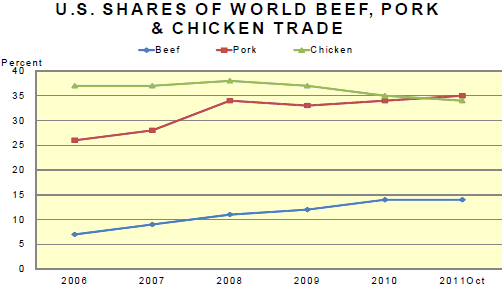



CME: World Meat, Poultry Trade; US Ethanol Blend Rate
US - A copyrighted story from the Oil Price Information Service (OPIS) published Tuesday evening says that EPA will formally announce an increase in the allowed ethanol blend rate from 10 per cent to 15 per cent on Wednesday afternoon, according to Steve Meyer and Len Steiner.According to OPIS, the increase will apply to cars made in 2007 and after. EPA had recently stated that it expected to make an announcement by mid- October but there was some speculation after last Friday’s very bullish USDA Crop Production report that the announcement might be delayed. OPIS reports that vehicles made in 2007 and after account for 18 per cent of the current light-duty fleet. OPIS says that EPA plans to rule on using the higher ethanol blends in 2001-2006 vehicles by the year’s end. Those account for 36 per cent of the nation’s current fleet.
Readers should note that this is an increase in the ALLOWABLE blend rate and not a requirement. There has never been a requirement regarding the percentage blended. The requirement to use ethanol has come from the Renewable Fuel Standard and is a total blending requirement. The RFS requirement for 2010 is 12 billion gallons of starch-based ethanol. With ethanol selling for very near the price of gasoline at present and containing only 2/3 the energy of gasoline, it is doubtful that many (or perhaps any) blenders will move to the 15 per cent rate any time soon. Such a move is made even less likely due to liability concerns, especially if the higher-ethanol fuel gets used in cars for which it is not yet approved.
While the change will not likely result in any immediate increase in ethanol usage or production and will thus not increase corn usage for ethanol production soon, it does promise an expanded market for ethanol producers who have been caught between the rising RFS requirements and the 10 per cent allowable blend rate. E85 was supposed to have made up the difference but has encountered difficulties in terms of both consumer acceptance and logistics.
Somewhat lost among the hubbub of the grain market news on Friday was the release of the Foreign Agricultural Service’s 2011 forecasts for world meat and poultry trade. The Executive Summary can be found here. The full circular will be released on Friday, 15 October.
FAS expects US pork and chicken exports to grow in 2011 but US beef exports to fall as prices rise. The top chart below shows data for 2006 to 2009, preliminary data for 2010 and USDA’s 2011 forecast. The bottom chart shows US shares of total world trade for the three species.


- Beef exports are expected to amount to 1.002 million metric tons (MMT), 3.3 per cent lower than in 2010. The US is expected to remain the world’s third largest beef exporter behind leader Brazil (2011 forecast of 1.810 MMT) and 2nd place Australia (1.325 MMT). The US share is forecast to drop slightly from 14.2 per cent for 2010 to 13.5 per cent in 2011.
- Pork exports are forecast to increase 4.6 per cent in 2011to a new record level of 2.121 MMT, barely eclipsing the current record of 2.117 MMT set in 2008. The “outlier” nature of 2008 can be clearly seen in the top chart as all other years’ export totals exhibit a slower but very steady growth rate. It is no surprise that the US will remain the world’s largest pork exporter with a forecast market share of 35 per cent in 2011. That figure is 1 per cent higher than our current record share set in both 2010 and 2008. The US is followed in the world pork rankings by EU-27 (25.5 per cent), Canada (19.4 per cent) and Brazil (10.5 per cent). US exports will comprise 20.8 per cent of production.
- US chicken exports are expected to grow by 2.8 per cent to 3.016 MMT. That total and our 34 per cent share trail only Brazil, which is forecast to export 3.45 MMT (38.5 per cent share) in ‘11.











